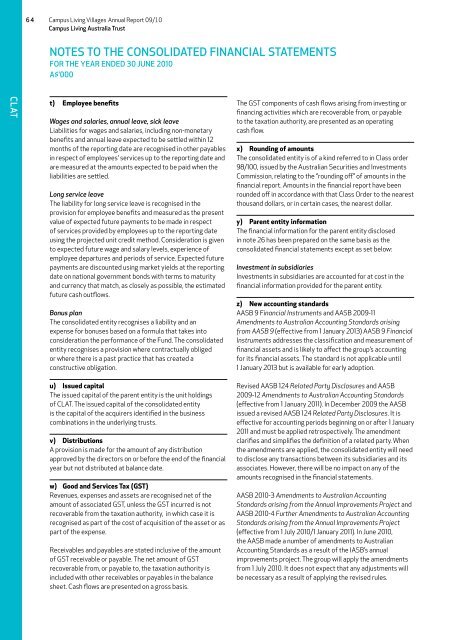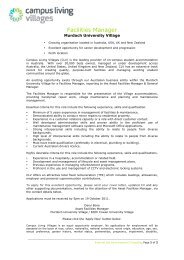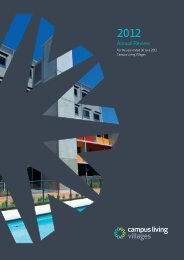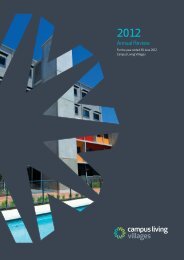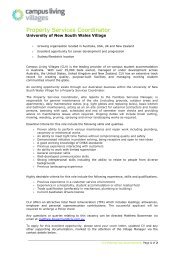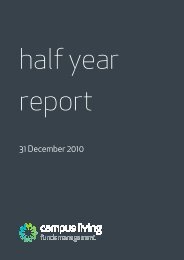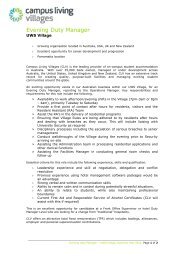Annual Report - Campus Living Villages
Annual Report - Campus Living Villages
Annual Report - Campus Living Villages
You also want an ePaper? Increase the reach of your titles
YUMPU automatically turns print PDFs into web optimized ePapers that Google loves.
6 4 <strong>Campus</strong> <strong>Living</strong> <strong>Villages</strong> <strong>Annual</strong> <strong>Report</strong> 09/10<br />
<strong>Campus</strong> <strong>Living</strong> Australia Trust<br />
NOTES TO THE CONSOLIDATED FINANCIAL STATEMENTS<br />
FOR THE YEAR ENDED 30 JUNE 2010<br />
A$’000<br />
CLAT<br />
t) Employee benefits<br />
Wages and salaries, annual leave, sick leave<br />
Liabilities for wages and salaries, including non-monetary<br />
benefits and annual leave expected to be settled within 12<br />
months of the reporting date are recognised in other payables<br />
in respect of employees’ services up to the reporting date and<br />
are measured at the amounts expected to be paid when the<br />
liabilities are settled.<br />
Long service leave<br />
The liability for long service leave is recognised in the<br />
provision for employee benefits and measured as the present<br />
value of expected future payments to be made in respect<br />
of services provided by employees up to the reporting date<br />
using the projected unit credit method. Consideration is given<br />
to expected future wage and salary levels, experience of<br />
employee departures and periods of service. Expected future<br />
payments are discounted using market yields at the reporting<br />
date on national government bonds with terms to maturity<br />
and currency that match, as closely as possible, the estimated<br />
future cash outflows.<br />
Bonus plan<br />
The consolidated entity recognises a liability and an<br />
expense for bonuses based on a formula that takes into<br />
consideration the performance of the Fund. The consolidated<br />
entity recognises a provision where contractually obliged<br />
or where there is a past practice that has created a<br />
constructive obligation.<br />
The GST components of cash flows arising from investing or<br />
financing activities which are recoverable from, or payable<br />
to the taxation authority, are presented as an operating<br />
cash flow.<br />
x) Rounding of amounts<br />
The consolidated entity is of a kind referred to in Class order<br />
98/100, issued by the Australian Securities and Investments<br />
Commission, relating to the ‘’rounding off’’ of amounts in the<br />
financial report. Amounts in the financial report have been<br />
rounded off in accordance with that Class Order to the nearest<br />
thousand dollars, or in certain cases, the nearest dollar.<br />
y) Parent entity information<br />
The financial information for the parent entity disclosed<br />
in note 26 has been prepared on the same basis as the<br />
consolidated financial statements except as set below:<br />
Investment in subsidiaries<br />
Investments in subsidiaries are accounted for at cost in the<br />
financial information provided for the parent entity.<br />
z) New accounting standards<br />
AASB 9 Financial Instruments and AASB 2009-11<br />
Amendments to Australian Accounting Standards arising<br />
from AASB 9 (effective from 1 January 2013) AASB 9 Financial<br />
Instruments addresses the classification and measurement of<br />
financial assets and is likely to affect the group’s accounting<br />
for its financial assets. The standard is not applicable until<br />
1 January 2013 but is available for early adoption.<br />
u) Issued capital<br />
The issued capital of the parent entity is the unit holdings<br />
of CLAT. The issued capital of the consolidated entity<br />
is the capital of the acquirers identified in the business<br />
combinations in the underlying trusts.<br />
v) Distributions<br />
A provision is made for the amount of any distribution<br />
approved by the directors on or before the end of the financial<br />
year but not distributed at balance date.<br />
w) Good and Services Tax (GST)<br />
Revenues, expenses and assets are recognised net of the<br />
amount of associated GST, unless the GST incurred is not<br />
recoverable from the taxation authority, in which case it is<br />
recognised as part of the cost of acquisition of the asset or as<br />
part of the expense.<br />
Receivables and payables are stated inclusive of the amount<br />
of GST receivable or payable. The net amount of GST<br />
recoverable from, or payable to, the taxation authority is<br />
included with other receivables or payables in the balance<br />
sheet. Cash flows are presented on a gross basis.<br />
Revised AASB 124 Related Party Disclosures and AASB<br />
2009-12 Amendments to Australian Accounting Standards<br />
(effective from 1 January 2011). In December 2009 the AASB<br />
issued a revised AASB 124 Related Party Disclosures. It is<br />
effective for accounting periods beginning on or after 1 January<br />
2011 and must be applied retrospectively. The amendment<br />
clarifies and simplifies the definition of a related party. When<br />
the amendments are applied, the consolidated entity will need<br />
to disclose any transactions between its subsidiaries and its<br />
associates. However, there will be no impact on any of the<br />
amounts recognised in the financial statements.<br />
AASB 2010-3 Amendments to Australian Accounting<br />
Standards arising from the <strong>Annual</strong> Improvements Project and<br />
AASB 2010-4 Further Amendments to Australian Accounting<br />
Standards arising from the <strong>Annual</strong> Improvements Project<br />
(effective from 1 July 2010/1 January 2011). In June 2010,<br />
the AASB made a number of amendments to Australian<br />
Accounting Standards as a result of the IASB’s annual<br />
improvements project. The group will apply the amendments<br />
from 1 July 2010. It does not expect that any adjustments will<br />
be necessary as a result of applying the revised rules.


